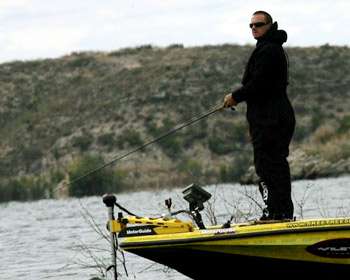
High winds forced the cancellation of a day of competition in two of the first three Elite Series events of the 2009 season. At the Toyota Trucks Diamond Drive on Arkansas' Lake Dardanelle, an impoundment of the Arkansas River, wind advisories forced the cancellation of the second day of competition, and the same thing occurred the following week at Alabama's Wheeler Lake.
The decision to cancel at Wheeler was as a result of the winds running opposite of the strong current being drawn through the Tennessee River impoundment. The current at Wheeler during the Evan Williams Bourbon Dixie Duel was exceptionally strong and, at times, quite dangerous.
However, as Elite Series pro and defending Classic champion Skeet Reese points out, current can oftentimes be a bass fisherman's best friend. "Anytime you're fishing in current, you're looking for something that's going to serve as a current break," he says. "Whether it's a rock, a stump, or a jetty — as long as it's a break in the current — bass will use it as an ambush point, so their positioning becomes pretty easy to figure out."
With current breaks setting up perfect places for bass to stage an ambush, Reese relays that the only decision bass fishermen face is whether the bass are staging on the upstream or downstream side of the current break. "More often than not, the active fish will be on the front side of the break, out in the main current looking for food," the former Toyota Tundra Bassmaster Angler of the Year says.
"Generally speaking, your fish that are a little more lethargic will be on the backside of a current break." With that in mind, Reese points out that in order to be successful in fishing current breaks, an angler has to be mindful of their bait's presentation. "Keep in mind that the objective when fishing around current breaks is to make your bait look and act as natural as possible," he explains.
"For example, you want your bait coming parallel with the current instead of against it." There are exceptions to that rule, however. "If you're going to back-troll, or run a fast moving crankbait that's trying to get a reaction strike, you're going to be fishing against the current, but those are definitely not the norm," Reese points out.
"Typically, if you're going to fish a jig or a worm, you want to make sure that you're parallel with shoreline so that the current brings the bait naturally downstream." For fishing current breaks, Reese has two primary weapons. "My two 'go-to' baits most of the time are going to be either a crankbait or a jig," he says. "If the bite's a little tougher, I will scale down to something like a shaky head (worm)." Boat positioning is every bit as important as bait presentation.
In fact, Reese maintains that it can be the difference between a single bite and multiple keepers from a single spot. "I always want to approach current breaks from the downstream side and work upstream," he reveals. "Get your boat positioned downstream of the object so you're able to fish all around it and control your boat in the current." For Reese, there's rarely too much current.
"As long as I can hold my boat in position with the trolling motor, I will fish it," he says. "I've caught fish in current that you wouldn't believe a bass would even go to, so they're not afraid of it. "If your trolling motor can keep you positioned, don't be afraid to get in there with them."
(Provided by Z3 Media)




